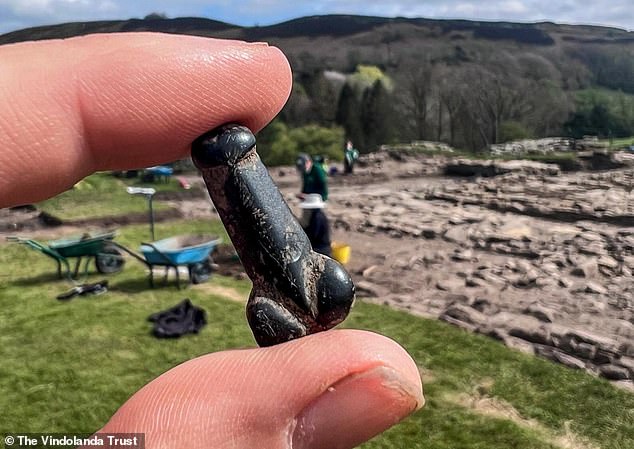
Ancient Roman Soldier’s Phallic Amulet Discovered at Northumberland Fort as Fortune-Boosting Talisman
Ancient Roman Phallic Pendant Unearthed at Vindolanda
Archaeologists have discovered a 1,600-year-old jet pendant shaped like a phallus at Vindolanda, a Roman fort near Hadrian’s Wall in Northumberland, England. The 1-inch (2.5 cm) black charm, carved from semi-precious jet, dates to the 4th century AD and was likely worn as a protective amulet to ward off evil or boost fertility. Its smooth surface suggests frequent handling, possibly for good luck.

The pendant’s smooth texture indicates it was touched often, possibly as a ritual for luck.
Dr. Andrew Birley, director of excavations at the Vindolanda Charitable Trust, called it a “wonderful little artefact” lost during the construction of a barrack wall. The find, made by a volunteer on April 25, will be cleaned and studied before going on display in 2026.
Phallic Symbols in Roman Culture
Phalli were common across the Roman Empire, symbolizing strength and used as talismans against misfortune. Small bone or metal versions were worn as pendants, while larger carvings adorned homes and public spaces. Pliny the Elder noted even infants and soldiers carried them for protection.

Vindolanda, near Hadrian’s Wall, served as a garrison base for Roman troops.
Not the First Phallic Find
This isn’t Vindolanda’s first risqué discovery. In 2023, a 6.3-inch wooden phallus was found, possibly used as a sex toy or ritual object. Its worn ends hinted at repeated use, though experts debated if it served as a pestle for grinding cosmetics. The site also features ancient graffiti pairing phallic carvings with insults, like branding a soldier named Secundinus a “s***ter.”

Vindolanda’s Rich History
Occupied from 85 AD to 370 AD, Vindolanda was rebuilt nine times, leaving layers of well-preserved artifacts. Famous for its wooden writing tablets—including a birthday invitation between women—the fort predates Hadrian’s Wall but later supported its construction. Today, the site’s museum showcases military gear, shoes, jewelry, and now, this ancient symbol of Roman superstition.
Why Phalli?
Romans viewed phallic imagery as a blend of humor and spiritual protection. From pendants to frescoes, these symbols permeated daily life, reflecting beliefs in virility and divine guardianship. As Dr. Birley notes, such finds highlight the personal lives of soldiers stationed at the empire’s edge.

The pendant adds to Vindolanda’s legacy as a window into Roman Britain, where practicality and mysticism intersected in unexpected ways. Visitors can explore the fort and its treasures year-round, connecting with a past where even the smallest charms held profound meaning.
(Word count: 598)


